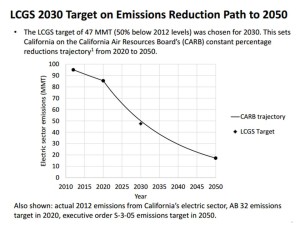In September 2015, California legislature passed SB-350: the Clean Energy and Pollution Reduction Act, also referred to as the 50/50/50 plan. There are two main goals for this plan (originally there were three, until the oil companies got involved).
Objective 1: (quoting directly from the bill) To increase from 33 percent to 50 percent, the procurement of our electricity from renewable sources.
These numbers may seem ambitious. With the exception of Hawaii, no other state’s mandate is higher than 30%. But if we look back on the history of California, we find that this goal is certainly achievable.
 Since the turn of the millennium, California’s renewable energy sources have steadily grown. Progress in the field can be traced back as far as the oil crisis in the 1970s, when we realized we needed to start seriously looking at alternatives. Then after the deregulation of the electric utilities in 1998, the CEC took charge of the Renewable Energy Program. Since then, we have continued to set higher goals, while providing incentives and enforcing the regulations necessary to reach them.
Since the turn of the millennium, California’s renewable energy sources have steadily grown. Progress in the field can be traced back as far as the oil crisis in the 1970s, when we realized we needed to start seriously looking at alternatives. Then after the deregulation of the electric utilities in 1998, the CEC took charge of the Renewable Energy Program. Since then, we have continued to set higher goals, while providing incentives and enforcing the regulations necessary to reach them.
In 2008, Schwarzenegger’s executive order set the bar at 33% by 2020, and it looks like we may get there (As of 2014, we were at 25%). But we won’t stop there. Most experts in the industry believe that 50% by 2030 is absolutely possible.
Objective 2: To double the energy efficiency savings in electricity and natural gas final end uses of retail customers through energy efficiency and conservation.
To paraphrase: We need to make the average building in California twice as efficient in terms of electricity and gas usage. At the same time, we need to motivate energy-conservative behavior such that energy demands remain about the same (despite the rise of electric vehicles).
Some believe this will be the more challenging of the two goals. But others are scratching their heads, wondering why this should be so difficult. And really, it shouldn’t be! Here are some simple numbers to illustrate this point:
1. The average duct in California leaks 30% of its conditioned air (tragically). On the other hand, the average duct sealed by Eco Performance Builders leaks less than 1% of its air (closer to 0%). And really, this should be the norm, because it’s not that hard to do. Imagine if every duct in California were sealed up properly. This alone would put us significantly closer to the goal. Arguably more important, if HVAC contractors stopped putting in gigantic over-sized furnaces and air conditioners attached to randomly sized and under-designed duct work, this would put us even closer to the goal.
2. Along the same lines, we can look at air leakage for an entire building (rather than just the duct). A good target air leakage rate is .35 ACH (air changes per hour). The average is much higher, though the exact number is difficult to pin down. It’s extremely wasteful, and it’s another way we can vastly improve energy efficiency.
3. Proper Insulation, HVAC right sizing and engineering, LED lighting, efficient water heating, Energy Star certified appliances, the list goes on.
There is plenty of room for improvement. The real problem is one of motivation and accountability. Most existing buildings in California were built at a time when energy efficiency was not a primary concern. Even now, most contractors are not held accountable for their sloppy work. And even now, energy efficiency is not a major selling point for a home (although it is starting to be and plans are in motion here).
We Must Have Accountability!
That brings us to one of the less widely known aspects of the SB-350 bill. That is, how are we going to motivate and measure our energy efficiency improvements? As far as the measurement, we have a promising new solution on the horizon. Currently, we use energy modeling software to predict energy savings results. While useful, it’s not 100% accurate by any means, and it does not directly measure results.
The goal is to eventually replace this method with a new type of software that will measure actual results, without having to install any physical devices in a home or other building, thus avoiding invasion-of-privacy issues. The proposed solution is an open source software called Open EE meter, or Open Energy Efficiency Meter.
This method will allow us to reward both contractors and customers for high quality work. To some extent, we are already doing this (for example, see here), but to reach our goals, it must be done on a much larger scale.
[dropshadowbox align=”none” effect=”lifted-both” width=”640px” height=”” background_color=”#ffffff” border_width=”1″ border_color=”#dddddd” ]Join the movement for a clean, efficient California! Call (925) 363-4498 or e-mail info@epbuilders.com to speak to a technician, or schedule an energy audit.[/dropshadowbox]

Speak Your Mind